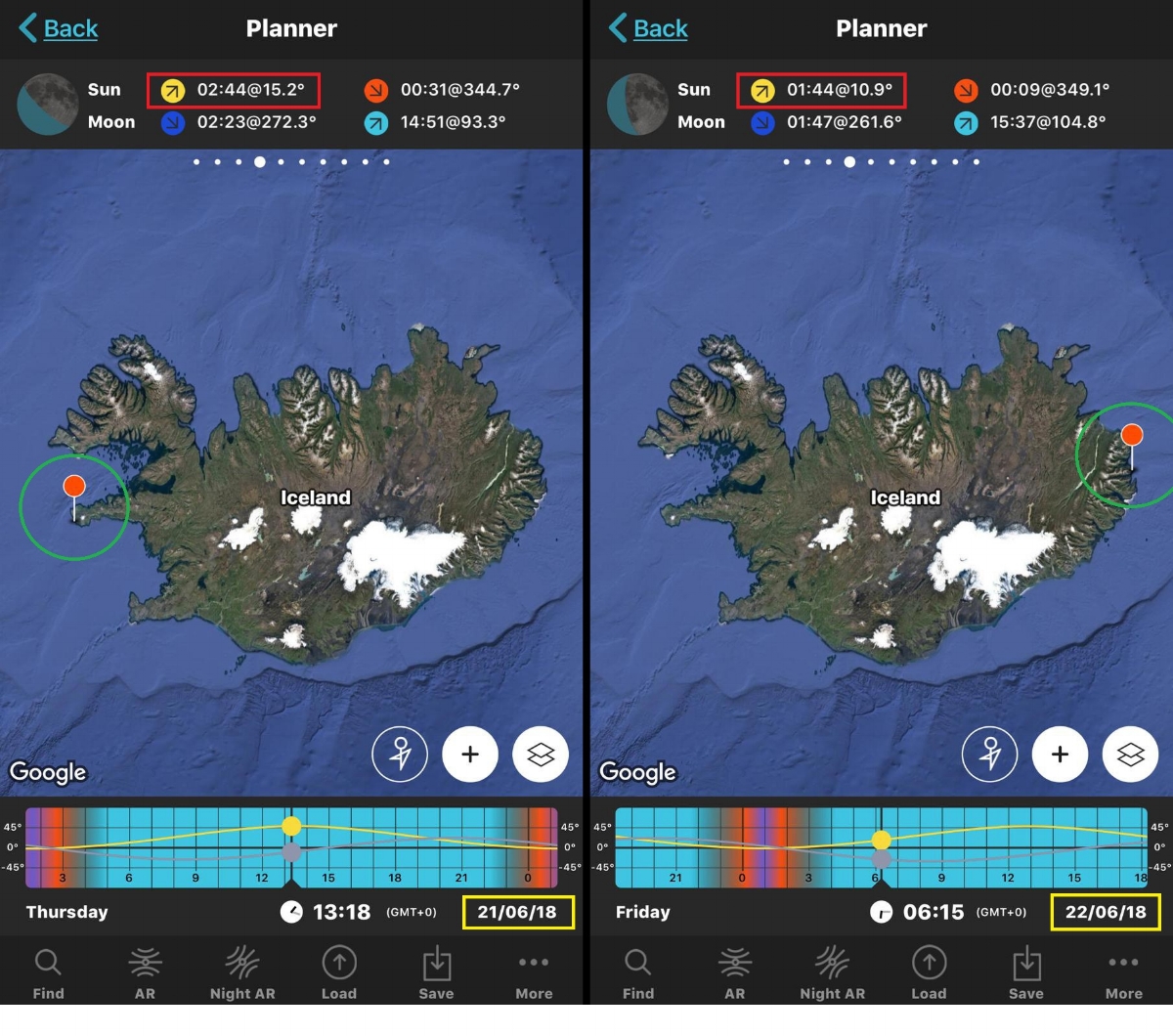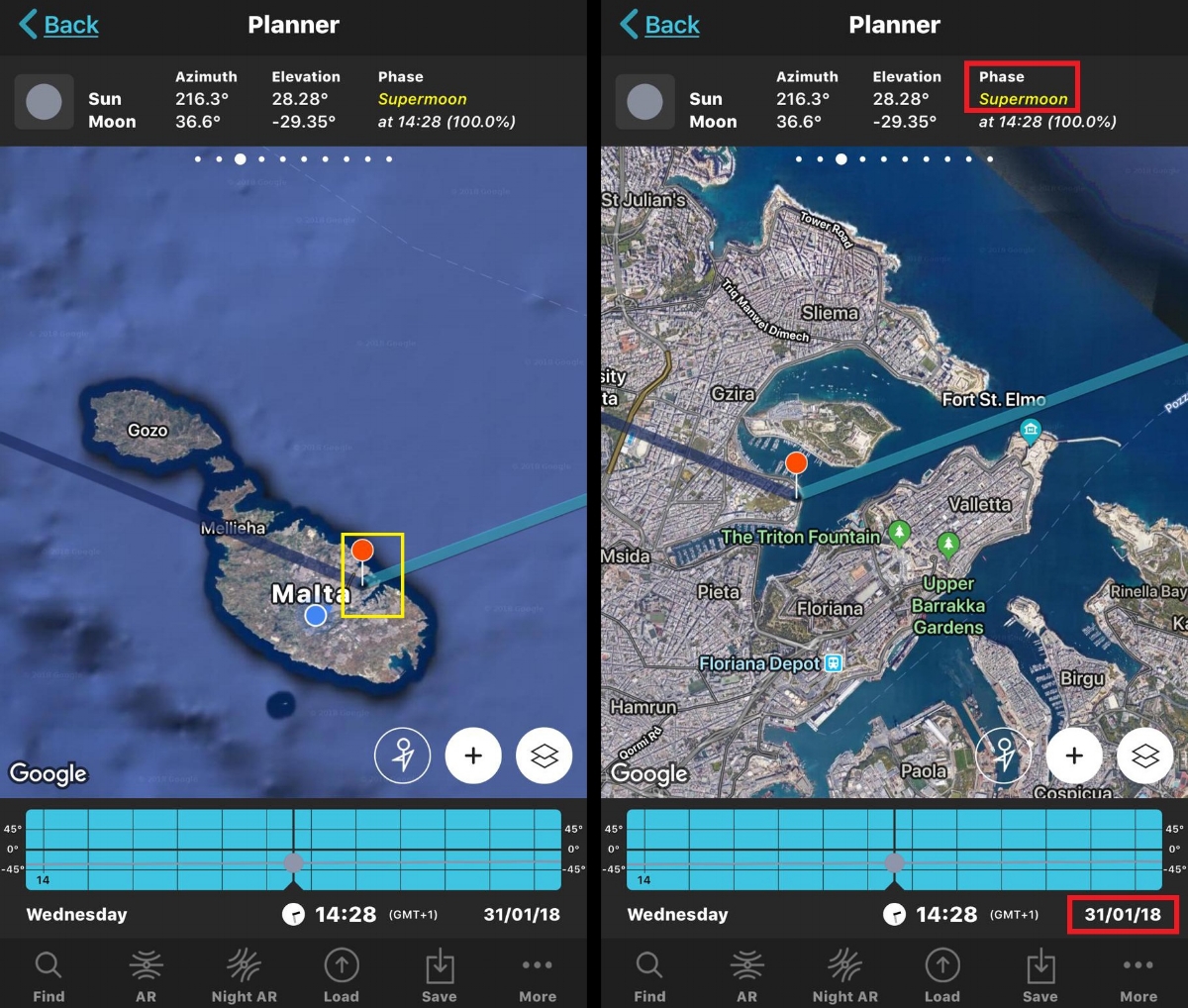Planning before photographing any location is extremely important. Although there is no substitution for going out and scouting locations with camera in hand, for certain shots, you need to plan properly to ensure you are at the right place at the right time and know what to expect.
Once you know the right time to visit a location, and by using various apps and tools (Explained in more detail below), you can visualise the shot you have in mind. At this point, the best thing to do is to head to the location nice and early to scout around and look for compositions which you can shoot as the light gets better.
Above: Being at the right place at the right time can make all the difference for your shots!
Day length
One of the most important factors to take into consideration is the fact that the sun rises and sets at different times every single day, this is referred to as Day length, and although here in Malta, there is only ever about 1 minute difference in the sunrise and sunset times for each consecutive day at a given location, in other countries it can be quite significant, for example in the North of Iceland, each day the sunset can be 4 to 5 minutes earlier or later than the previous day.
Although this might not seem like much, its something to keep in mind, as it can make a difference to your planning and can quickly add up (If for example you were in the same location in Iceland for 2 weeks, the sunset time could differ by over an hour between the first and last day.
Sunrise and Sunset times from 1st to 15th October in Akureyri, Iceland. As can be seen from the highlighted fields, sunrise is 23 minutes later and sunset is 26 minutes earlier on 10th October, compared to 3rd October.
Azimuth and Latitude
Another really important point to keep in mind is the difference in the sun’s Azimuth at sunrise and sunset at different times of year. (The Azimuth is the relative location of the sun). Looking at Malta as a specific example, in Summer, the sun rises in the North East and sets in the North West, and in Winter, the sun rises from the South East and sets in the South West.
After the summer equinox, the sun starts rising further south every day until it reaches its furthest south at the winter equinox, when it then starts rising further to the North each day. (The minimum Azimuth and Maximum Azimuth are around the equinoxes, 21st June and 21st December).
The below images show the Azimuth of sunrise and sunset for both Malta and Iceland at both Summer and Winter Equinoxes. This clearly shows that the sun rises and sets much further to the North in Iceland than it does in Malta, in summer. The sun also rises and sets much further to the South in winter, these variations are due to the difference in Latitude between Iceland and Malta.
This comparison shows the difference in the Sun’s azimuth at Sunrise and Sunset. Left: Sunrise Direction (Yellow Line) and Sunset Direction (Orange) on 21st June 2018; Right: Sunrise Direction (Yellow Line) and Sunset Direction (Orange) on 21st December 2018.
Screen grabs of the App ‘Photopills’ showing an example of variation in sunrise and sunset times and Azimuths at the two Equinoxes.
Left: At the summer Equinox (21st June) sunrise is at 02:23AM and sunset is at 00:09AM - That’s a really long day!
Right: At the winter Equinox, sunrise is at 11:24AM and sunset is at 3:02PM. That’s a really short day!
Longitude
Also quite interesting, and probably the most important factor when planning, is how much the sunrise and sunset time changes depending on your longitude. Here is an example: If you are on the West coast of Iceland, say on the Snæfellsnes peninsula, sunrise would be 02:44am on the 21st June, if on the next day, you drove to the East coast of Iceland, say to the village of Seyðisfjörður, the sun would rise at 01:44am, that’s a whole hour difference just because of your Longitude (Position East - West).
Sunrise is a whole Hour later at Snæfellsnes than it is at Seyðisfjörður. Left: Sunrise time on the Snæfellsnes peninsula, on 21st June was at 02:44 ; Right: Sunrise time at Seyðisfjörður, on 22nd June was at 01:44.
Now that we got all that out of the way, I think its fair to say that you appreciate just how much variation there is between different times of year and locations, so we can actually get down to planning! Its also this variation which gives us loads of different locations to visit throughout the year, as if the sunrise or sunset was in the exact same location every day, we would be a lot more restricted to the places we could visit!
Google Maps
The first thing that I do when planning a trip is to use google maps (Satellite imagery) to scour the area and find the exact location that I want to shoot from. Google maps is really helpful as it gives you a birds eye view of the location and you will have an idea what to expect. Its also important to use the 3D aspect of google maps to give you have an understanding of the topography of the location, as sometimes there can be some very challenging surprises, especially when there is an unexpected cliff between you and your location!
Some of the Apps which can be used to plan for a specific photo:
Photopills
The Photographers Ephemeris
Planit!
SkyGuide
SunCalc
Sun Route
I use Photopills for all my planning, whether it is for sunrise, sunset, the Milkyway or a photo with the moon in it. I use Photopills because it shows you more than just the times and azimuths of sunrise and sunset, but also shows the moon’s phase, and gives a great graphical representation of the Milkyway and where it will be located. It also has augmented reality to help you visualise the the photo before you capture it. Photopills also has loads of other great functions such as exposure, depth of field and hyperfocal distance calculators, a timelapse calculator and also the ability to save plans for future trips.
Planning a Sunrise / Sunset shot
I use Photopills to plan all my shots / trips. Below is an example of planning a sunrise shot. The ‘Ras il Mignuna’ natural sea arch is in the south of Malta, it is the perfect place to shoot sunrise in winter, because of it’s location. However, because it is so far south, the sun rises and is visible on the horizon just during the months of December and January.
Planning for a sunrise shot at ‘Ras il Mignuna’, a natural sea arch in the south of Malta. The sun is only visible for a few weeks each year around the winter equinox.
The result - After visiting this location 7 or 8 times, I finally got an amazing sunrise and it just made the perfect shot of this location!
Planning a Milkyway shot
Photopills makes planning a Milkyway shoot really easy! Below is an example of how I have used Photopills to plan a specific shot of the galactic center of the Milkyway behind a Chapel in Dingli. Photopills shows you the exact location of the Milkyway, including its Azimuth and Elevation in the night sky.
Left: I dropped the pin on the location I want to shoot. Centre: I then zoom in to see the exact location. Right: After choosing the date and time, Photopills shows you the exact location in the sky where you will find the Milkyway, including its Azimuth and Elevation.
The result: The Galactic Center (Core) of the Milkyway behind the chapel of St Mary Magdalene in Dingli.
Planning a moon rise shot
31st January 2018 was a date I had been looking forward to for ages! Firstly because there was a rare celestial event, A Super Blue Blood moon, and secondly because it was my Birthday! I had planned the shot months in advance and headed to the location on the day to get the shot I had in mind.
Left: The yellow box shows the location I chose for this shoot, which was Ta’ Xbiex, as I wanted to capture the moonrise with the Valletta skyline. Right: The date (31/01/2018 and phase of the moon are highlighted in red.
Left: The purple arrow shows my location and the direction I would be shooting. Right: You can see the moon rise time listed as 17:34.
The Result - A Super Blue Blood moon rising behind the Valletta skyline on 31st January 2018!
On Location
I’m a strong advocate of arriving on location early. If its a location I have shot many times, 30 mins before sunrise or sunset is enough, as I would know what compositional options are available and can chose the most appropriate one depending on the light.
If its a location I have never visited before, I will sometimes go there several hours before sunset to scout and look for little details / interest and a strong composition. If its a sunrise location, I would recommend scouting the location previously so that you will know what to expect, this can be done during the day, and using augmented reality in Apps can show you where the sun will rise.
The reason for arriving on location early is that the light will not always do as you predict, clouds can significantly change your composition, and you may not be able to use the composition you had planned to.
Being there early allows you to observe what is happening around you (The direction the clouds are moving, the way the waves are crashing against the rocks, whether you will have direct sunlight on your foreground or just a colorful sky) and you can make the most of the conditions.
As mentioned above, planning your shots is extremely important, and will show you the right time and place that you need to be to get the shot. This guide isn’t meant as a Photopills user guide (There are plenty of those on their website), its meant to give you an idea of the amount of planning that goes into nailing certain shots and hopefully shows the importance of proper planning!












